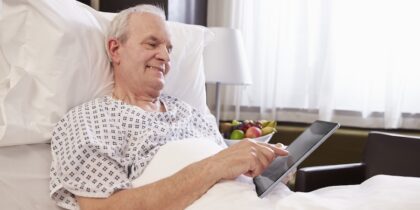Home is where the heart is. It’s where people raise their children, make some of their fondest memories and find respite from the outside world. So, it should come as no surprise that home is exactly where seniors want to spend their golden years. However, as health or cognitive function declines, many seniors reach a point at which living alone is no longer a safe option. In the past, they had three alternatives: live with family members, hire an around-the-clock caregiver or move into a skilled nursing facility.
Now, there’s a third option: the Connected Home.
There’s No Place Like Home
Baby boomers are known for their independent nature, and aging hasn’t changed that. According to AARP’s Home and Community Preferences of the 45+ Population study, 86 percent of baby boomers want to remain in their homes for as long as possible, and 85 percent want to stay in their local communities. The problem is that along with rising healthcare costs, there’s also a shortage of potential caregivers for this large, aging population. In 2010, there were 7.2 potential caregivers for every person over age 80, according to a 2013 report by the AARP. By 2030, when all baby boomers will have reached old age, the caregiver ratio will drop to 4 to 1.
That’s why Samsung and CDW Healthcare have been collaborating on a vision for the Connected Home, an initiative to make the lives of seniors easier while living by themselves at their homes. The concept is to embed Samsung technology into the home, giving seniors the ability to better track their health in a comfortable, familiar setting.
Connected and Protected: The New Way to Age in Place
A Connected Home includes one or more devices with an Internet connection that could be controlled through an app on users’ mobile devices or smart television. For seniors, these solutions fall into three categories: home functionality, enhanced lifestyle and health monitoring.
The Samsung SmartThings Hub would connect sensors placed throughout the home, which can detect room characteristics such as temperature and status changes such as doors opening or closing. These features help to keep intruders out of the home, while keeping seniors safe inside. The SmartThings Hub would also connect with wearable devices, such as the SmartSense Presence sensor, which tracks the location and body position of seniors within the home, alerting family members or physicians when seniors fall or are in distress. The Samsung mobile devices can be connected to wearable health sensors — such as blood pressure cuffs, weight scales, glucometers and heart monitors — which enable seniors to share health data with care providers in real time.
This digital health technology helps family members and healthcare providers monitor patients, while empowering seniors to remain in a familiar and comfortable place. Dr. David Rhew, chief medical officer at Samsung Business, summarizes this in a 2015 interview with CDW. “Perhaps the most significant opportunity with the Connected Home for seniors lies in its potential to improve care and reduce healthcare costs,” said Rhew. “The Baby Boomer population in the U.S. is expected to double between now and 2050, and healthcare costs will increase accordingly… Monitoring of seniors’ health in the home setting can enable the early detection of problems, promote proactive interventions by healthcare providers and minimize hospital and long-term care costs.”
This is good news for both healthcare companies and the families they serve, as this may change how people take care of their loved ones. Utilizing mobile devices to keep better track of health, whereabouts and well-being can revolutionize the healthcare industry.







